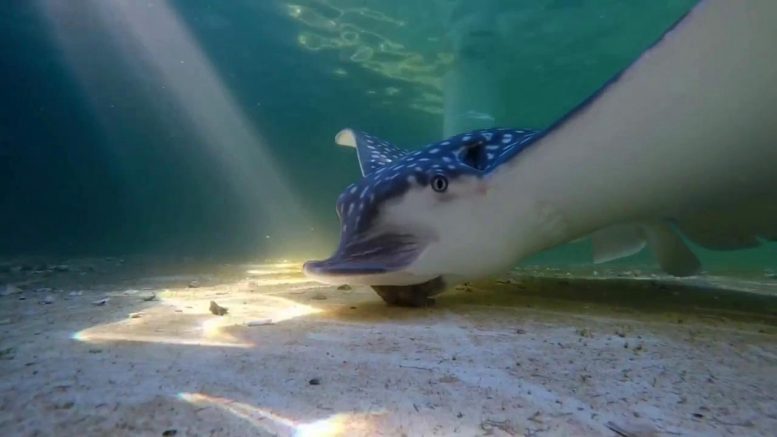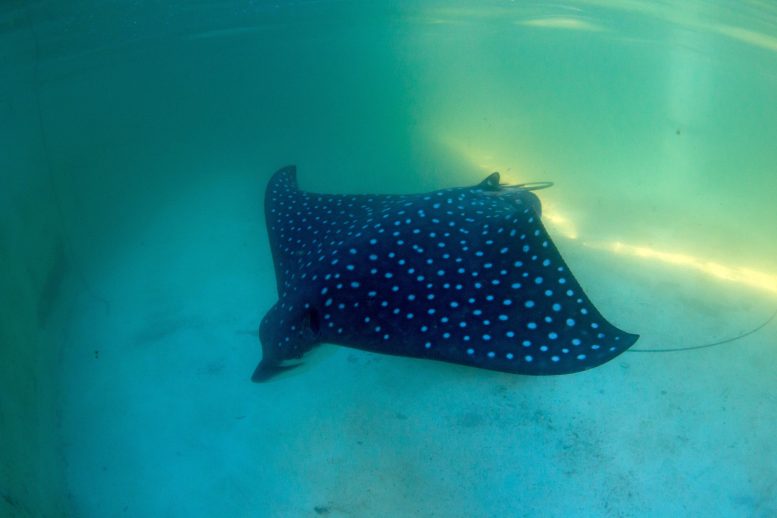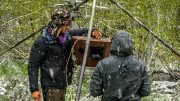
The whitespotted eagle ray (Aetobatus narinari) break apart hard shells like clams, oysters and conch using their fortified jaws to access the prey’s soft tissues. Credit: Florida Atlantic University’s Harbor Branch Oceanographic Institute
Scientists first to quantify consumption noises using whitespotted eagle rays.
“Shell-crushing” — exactly what it sounds like — is a predatory mode used by numerous marine life from crabs to octopuses to large fishes and mammals when they eat hard-shelled mollusks like clams, oysters and conchs. These predators have to break apart the shell using robust claws or fortified jaws to access the prey’s soft tissues.
Despite its prevalence in the marine environment, this feeding behavior has remained elusive to study remotely, particularly for larger marine animals that destroy shells almost completely, leaving behind little trace. Moreover, because they are highly mobile, scientists have difficulty in directly observing their foraging habits, which is why the ecology of shell-crushing (durophagy) remains poorly understood in larger marine predators and the ecosystems with which they interact. So, there is little understanding of where or when this happens.
Turn up the sound! Using the whitespotted eagle ray and underwater acoustic recorders, a study is the first to characterize how they consume hard-shelled mollusk prey like clams in a controlled environment. Scientists could tell what a predator was eating based on how it sounds, and with this process it’s audible above ambient noise in coastal lagoons out to 100 meters. The team hopes this technology will be useful in monitoring how many clams are being eaten by large predators like rays as restoration efforts ramp up in Florida. Credit: Florida Atlantic University’s Harbor Branch Oceanographic Institute
Using the whitespotted eagle ray (Aetobatus narinari) as a model, a team of scientists led by Florida Atlantic University’s Harbor Branch Oceanographic Institute in collaboration with FAU’s College of Engineering and Computer Science; Mote Marine Laboratory & Aquarium; and the Florida Institute of Technology, are the first to use passive acoustics to characterize how they consume hard-shelled mollusk prey in a controlled environment.
Scientists both quantified and classified shell-crushing by monitoring underwater sounds using acoustic recorders. Results, published in the Journal of Experimental Marine Biology and Ecology, reveal that using this technology, prey types could be distinguished based on acoustic features. Researchers were able to determine what a predator is eating based on how it sounds. In addition, shell-crushing simulation tests in the natural environment suggest the process is audible above ambient noise in coastal lagoons out to 100 meters.

The highly mobile whitespotted eagle ray (Aetobatus narinari) consumes a wide variety of mollusk species, including both bivalves and gastropods. Credit: Mote Marine Laboratory & Aquarium
“Interactions between molluscan predators and shellfish often occur in low-visibility estuarine waters. Scientists need alternative non-visual based methods to continuously monitor, gather and document critical data that may have serious conservation ramifications,” said Matt Ajemian, Ph.D., lead author, an assistant research professor at FAU’s Harbor Branch and head of the Fisheries Ecology and Conservation (FEC) Lab, who worked with FAU Harbor Branch co-authors Laurent Chérubin, Ph.D., an associate research professor; and Breanna DeGroot, M.S., research coordinator. “Passive acoustics-based documentation of shell-crushing behavior has not been seriously considered as a tool to identify the ecological role of large, mobile molluscivores before this study. We knew from previous experience with these animals that the cracks they made during feeding were loud, almost like an explosion, but there were no data to support it at the time. That’s what led us to conduct this initial study.”
Whitespotted eagle rays consume a wide variety of mollusk species, including both bivalves and gastropods. For the study, scientists recorded a total of 434 prey items being eaten by rays, spanning eight species of hard-shelled mollusks. On the menu: hard clams, banded tulip, crown conch, lettered olive, Florida fighting conch, lightning whelk, pear whelk and horse conch.
“Mollusks vary in texture, thickness and strength. The differences we observed in consumption signals and behavior associated with the two primary prey types analyzed are likely due to variations in these shell shapes,” said Kim Bassos-Hull, M.Sc., co-author and senior biologist with Mote Marine Lab’s Sharks & Rays Conservation Research Program. “It was clear that hard clams took a considerably longer time to process than banded tulip shells and all other gastropods. This was likely driven by the greater number of fractures rays needed to implement during processing and winnowing of hard clams presumably to access the prey’s soft tissues.”
Signal characteristics of simulated crushing of hard clams in the field, which the researchers conducted by crushing clams by hand using modified heavy-duty pliers, also were similar to those recorded in the large, circular saltwater habitat.
“It’s obviously hard to get a ray to eat on command in a particular time and place, so we had to get somewhat creative with the field testing,” said Ajemian.
Data from this study are critically important with respect to molluscan shellfish, which provide high-quality and high-value seafood to humans, and beneficial ecosystem services, yet sources of natural mortality from large predators are largely unknown for both natural and restored populations.
“The passive acoustics approach demonstrated in our study provides a unique, less-intrusive platform to remotely and directly observe predation events like shell fracture in the aquatic environment and support surveillance techniques to quantify predator-induced losses to these valuable resources, even in challenging environmental conditions,” said Chérubin.
The team is hoping this technology will be of utility in monitoring how many clams are being eaten by large predators like rays as restoration efforts ramp up around the state of Florida.
“We still have a lot of work to do on the automated detection-classification side of things, but this work brings us closer to remotely capturing predation in these elusive species,” said Ajemian.
Reference: “Capturing shell-crushing by large mobile predators using passive acoustics technology” by Matthew J. Ajemian, Catherine Lamboy, Ali Ibrahim, Breanna C. DeGroot, Kimbrough Bassos-Hull, David A. Mann and Laurent Chérubin, 17 December 2020, Journal of Experimental Marine Biology and Ecology.
DOI: 10.1016/j.jembe.2020.151497
Study co-authors are Catherine Lamboy, Department of Ocean Engineering and Marine Sciences, Florida Institute of Technology; Ali Ibrahim, Ph.D., Department of Computer and Electrical Engineering and Computer Science, FAU’s College of Engineering and Computer Science; and David A. Mann, Ph.D., president, Loggerhead Instruments, Inc.
This work was funded by a grant from the Save Our Seas Specialty License Plate program (AWD-001259) administered by the Harbor Branch Oceanographic Institute Foundation.









So, when does the culling of white spotted rays begin?